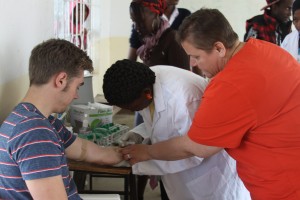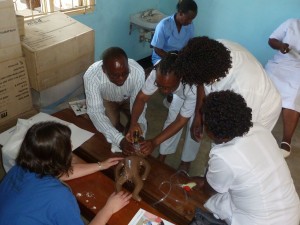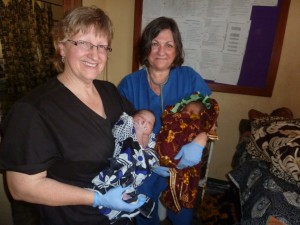Medical Sciences and Lab Skills

Leah Narans oversees New Life Band School student Anna, who is drawing blood from Hope 2 Others volunteer Drew Lund.
Hope 2 Others volunteer Leah Narans is spending the summer in Tanzania. For the past five weeks, she has been teaching New Life Band School students an introductory course about medical sciences and lab skills. Topics she has covered include microbiology, hematology and urinology. The last week of the course, from June 23-27, focused on teaching the students how to draw blood.
Since our first team of Hope 2 Others volunteers visited the school from June 25-27, they were able to provide some fresh arms and good veins for the students to practice on. They demonstrated proper procedure and practical knowledge by securing the tourniquet tightly, feeling for a good vein, swabbing the arm, and finally, with Leah’s supervision, inserting the needle. Some students filled a vial with blood, others missed and did not get anything. This is just an introductory class. Students who wish to go into the medical field will need to take more advanced classes at the university, just like in the United States. But it is a good start and a great way to give the students hands-on knowledge.
Healthy Births and Babies
For the past seven years, the Madison Meriter NICU nurse – aided by friend and midwife Nancy Comello – has been teaching Hope 2 Others’ Healthy Births and Babies program in Guatemala.
Healthy Births and Babies focuses on many issues, including: helping pregnant women stay healthy; recognizing and responding to complications of pregnancy and delivery; teaching strategies, birthing techniques and positions to improve the safe delivery of baby and mother; addressing what to do in case of postpartum hemorrhage; teaching newborn care and keeping babies healthy by keeping mothers and babies together after birth; kangaroo care; the importance of breastfeeding and the Golden Hour after birth; and teaching good nutrition.
During a month-long trip to Tanzania in January, Karen Klemp and Nancy Comello taught Healthy Births and Babies to Tanzanian midwives and birthing attendants.
“The goal is to really care for women so they can care for their own babies, it is not taking over that role,” Nancy Comello said. “That is something I feel called to, and to empower women to try to be the best mothers that they can be, that is what our goal is.”
Helping Babies Breathe

Karen Klemp oversees a Helping Babies Breathe workshop in Tanzania. In the event a baby is not breathing after birth, participants are taught to clear the mucus from the airway and give rescue breaths.
Karen Klemp and Nancy Comello also teamed up to teach the American Academy of Pediatrics’ Helping Babies Breathe program for the first time in Tanzania in January 2014. Both were instructed in the program by Dr. Julie Kessel and are certified Helping Babies Breathe Master Trainers.
A key component of the Helping Babies Breathe program is teaching a person to recognize newborns who are having difficulty breathing at the time of birth and taking appropriate action to help the baby start breathing.
“One of the real crucial points is the Golden Minute, which is the first minute following birth,” Karen Klemp explained. “It is really important that the birth attendant or the midwife or the nurse or whoever is assisting with the delivery of the baby knows that the baby needs to be supported temperature-wise, is stimulated to breathe and there is assisted ventilation as needed. And that all happens within the first minute of life, which is called the Golden Minute.”
As part of Helping Babies Breathe, Karen Klemp and Nancy Comello taught the Tanzanians gathered how to suction a baby’s mouth if there was too much mucus and how to give breaths, as well as how to use a bulb syringe and a mask.
“If the baby is not breathing, typically many of them are assumed to not be alive,” Karen Klemp explained, adding that skills such as stimulating the baby, clearing the mouth of mucus and giving breaths were new concepts for many in attendance.

